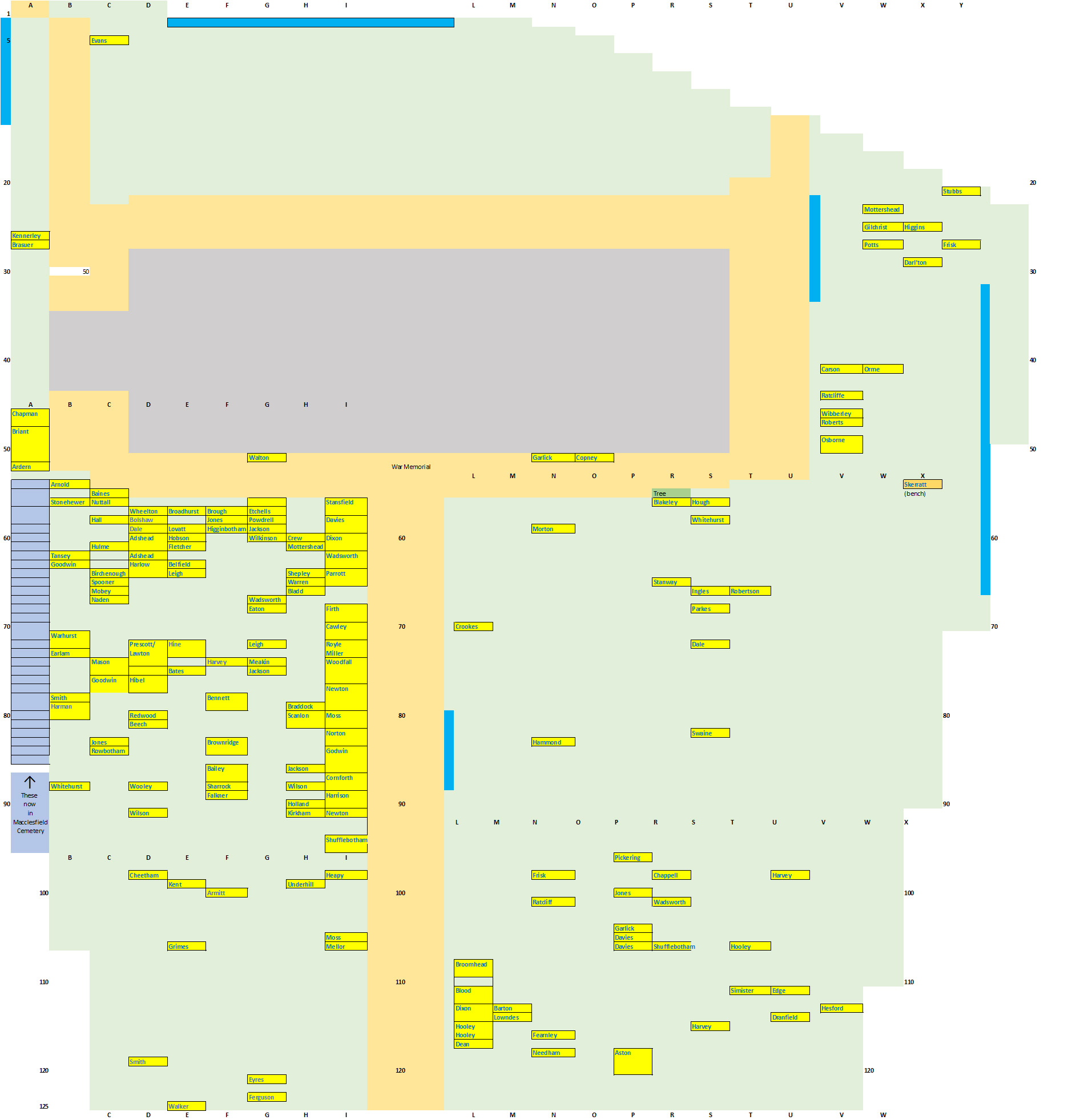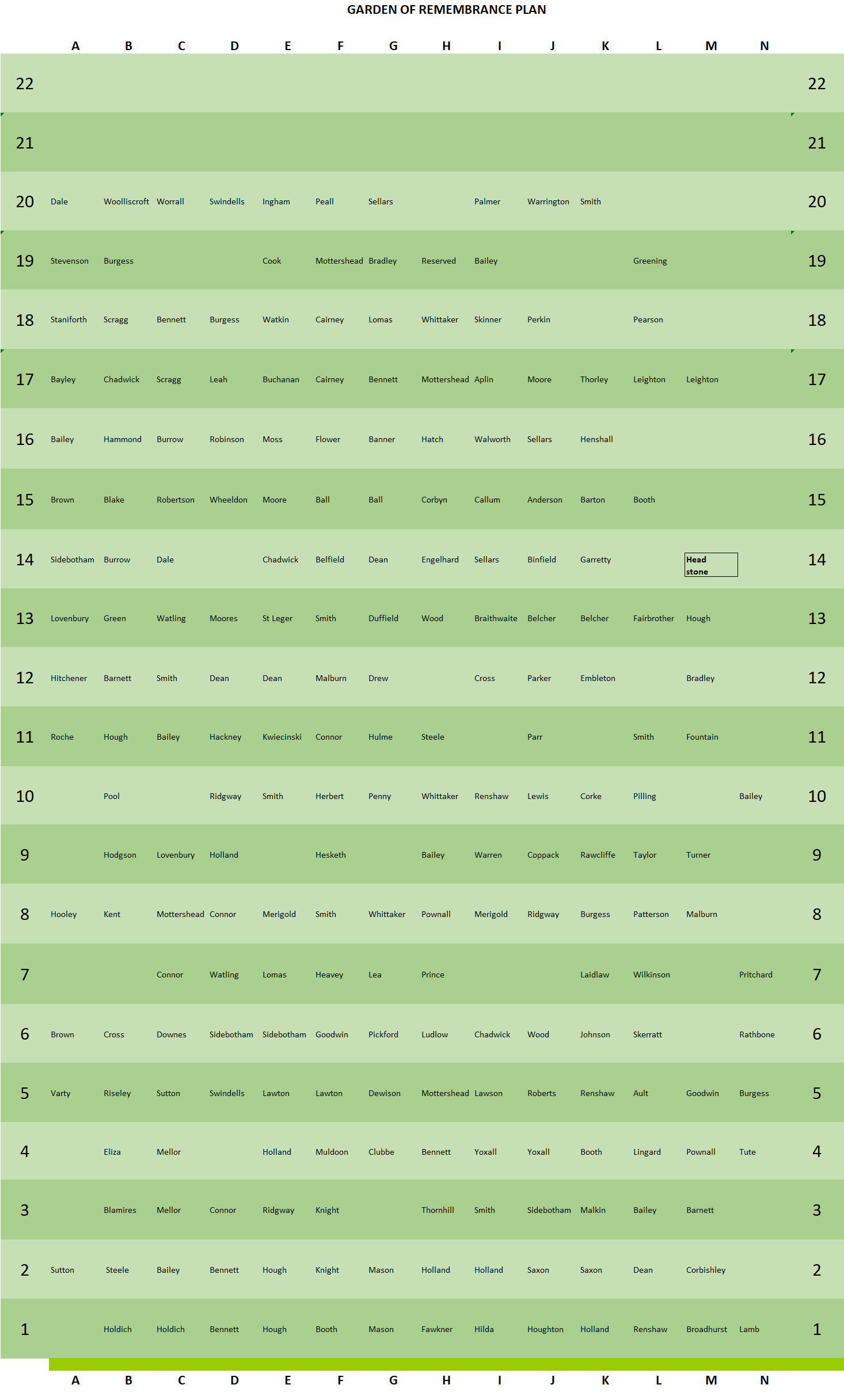
THIS IS A WORK IN PROGRESS
Transcriptions of burial records and some baptism records are available NOW
transcriptions of marriage records will be added later.
This page includes details of the churchyard layout.
Use the menu buttons at the top right to search the register transcriptions.
If your search brings up a map reference to a memorial inscription, come back to this page to see maps of the churchyard and Garden of Remembrance.
St Paul, Macclesfield
A number of Parish Registers of baptisms, marriages and burials at St Paul's are still held at the church, but others are kept at the Chester Record Office.
If you need a certified copy of a register entry, contact the parish office in the first instance.
If you need a certified copy of a register entry from any of the registers held at Chester, it can only be obtained from the Chester Record Office.
Transcriptions of some parish registers can be searched online on this website.
This is a work in progress. More transcriptions will be added over time.
When searching for details of burials and memorials. It is important to note the following:
- The burial registers usually DO NOT IDENTIFY THE LOCATION of individual burials within the churchyard.
- Relatively few graves have memorials with inscriptions.
So although the burial register can confirm whether an individual's remains were interred in the churchyard, the records may not identify the location of a grave.

David Dixon / St Paul's Parish Church / CC BY-SA 2.0
VISITING THE CHURCHYARD
Although the churchyard is normally open to visitors at all times, it is not supervised.
You need to ensure your own safety, as you would when visiting any other churchyard.
- The ground is uneven in places.
- Some headstones that were originally vertical have now fallen flat.
THIS CAN STILL HAPPEN TO OTHER HEADSTONES!
particularly after severe weather, where the ground is saturated/softened by heavy rain.
Instability can also be caused by the growth of tree roots or the activities of burrowing animals - this danger may not be evident from the surface. - Some standing headstones are showing signs of splitting or cracking with age or weathering. Parts of these stones may break off.
DO NOT climb on or lean against vertical headstones.
DO NOT get too close to a headstone that is leaning away from the vertical.
DO NOT ALLOW children to run around or play games in the churchyard.
THE CHURCHYARD LAYOUT
St Paul's church is laid out on the traditional east-west axis, with the altar at the east end.
In general, the burial plots also followed the traditional east-west layout. Coffins would have been buried with the head of the deceased at the west end. As the name suggests, a headstone would also have been at the west end of the plot and the inscription is usually on the east face of a headstone.
In the 1960s, there was some concern that part of the churchyard wall alongside Green Street was in danger of collapsing. Macclesfield Council carried out remedial work, and in preparation for this, a number of memorials adjacent to the wall were relocated to Macclesfield Cemetery, presumably also with any identifiable remains from the burial plots.
THE MEMORIALS
To the left of the path up from Brook Street are a number of large memorials, some probably constructed over brick-built vaults.
It is likely that some of thise large plots would have been purchased by well-to-do families when the churchyard was first opened. The revenue from such sales could have been used to partly finance church furnishings.
There are a number of "small stones", mostly now placed alongside the churchyard walls, with others standing on the right hand side of the side of the path leading up to the church from Brook Street.
These stones were originally in the area to the north of the church, and were moved to facilitate the construction of the parish rooms.
No record of the original layout of the small stones has been found.
It is likely that the graves in this area were relatively shallow, intended mostly for single coffin burials. Most would probably have been for the burial of parishioners with little or no money. It is known that some burials had to be made at the expense of the parish.
Many of the other burial plots would have been purchased by families. They would have been intended to contain up to four adult coffins (so they would have been dug to a depth of 12 or 13 feet).
In some areas of the churchyard there are remarkably few visible memorials.
It is known that some headstones have sunk into soft ground. Others that were laid horizontal (or fallen from the vertical) have, over time, been grassed over.
It is not known how many memorials have "vanished" in this way.
The memorials were surveyed by the "Macclesfield Ferrets" 1988 to 1999 and again by Dave Williams in 2024.
Some of the memorials that were recorded in the earlier survey are no longer visible.
It is important to remember that inscriptions on headstones are not necessarily a record of the individuals buried in the relevant plot. Some of those buried in a plot may not be recorded on the associated inscription; others may be commemorated on the inscription but buried elsewhere.
As well as the moved "small stones", a number of other memorials are not now in their original locations. Some have simply fallen - so may now be in the row adjacent to the original burial plot. Some fallen memorials have been moved some distance from where they fell, and at least one fallen memorial has been re-erected a little distance from its original location`.
There are a number of discrepancies between details on inscriptions and the associated burial register entries. Many of these are related to the small stones.
There also a number of memorials within the church building. Several of these commemorate individuals associated with the parish, but who died after the closure of the churchyard and whose remains were therefore interred elsewhere.
CHURCHYARD MAP
The map is drawn as a spreadsheet with North at the top. Brook Street is at the bottom of the map, with the pathway up from Brook Street and around the church in orange. The Parish Rooms are not shown.
In reality the churchyard is not rectangular and the arrangement of burial plots is not so regularly aligned!
The boxes coloured yellow indicate the approximate locations of visible memorials, with one or more family surnames commemorated on the inscription.
The four blue bars show the rows of relocated "small stones".
The grey area at the left of the map shows the original location of the memorials now moved to Macclesfield Cemetery.
Many of the memorials are not in their original location, so may not indicate the relevant burial plot.

GARDEN OF REMEMBRANCE PLAN
The map is drawn as a spreadsheet with North at the BOTTOM. This orientation is what you would see looking at the Garden of Remembrance with your back to the church.
The Garden of Remembrance is located next to the path around the church, a little to the east of the War Memorial.
There have been more interments of cremated remains since this plan was drawn.

THE BURIALS
The first burials were recorded on 28 November 1844.
In the middle of the 19th century there were a number of outbreaks of cholera and typhoid in towns and cities across the UK. There were concerns that water seeping from burial yards on high ground could find its way into watercourses from which people obtained drinking water.
This prompted the construction of municipal cemeteries (as well as the gradual introduction of mains water supplies).
St Paul's churchyard was one of many burial grounds that was affected by such concerns. In 1855 it was ordered to discontinue the burial of more than one individual in a grave. In 1866, St Paul's churchyard was officially closed, following the opening of Macclesfield cemetery.
"Closure" meant that no new graves could be dug, although burials were still permitted in family plots that had been purchased before the closure. (It seems likely that this dispensation was also applied to the 1855 order.)
Burials peaked during the 1850s, with 980 burials in the years 1855-1859 - about 4 per week on average.
About half the burials recorded before the closure were of children under 10 years of age (and half of these were babies).
The vicar and his curate (if he had one) were kept very busy during this period, so it is perhaps understandable that some burials seem not to have been recorded.(The omissions are mostly associated with the "small stones", ie the poor of the parish. There are also discrepancies between inscriptions and burial register entries, again mostly affecting the "small stones".)
During the period that St Paul's church was "open", the law gave all those living within the parish the right to be buried in the parish churchyard as long as there was space to do so. They had to have a Church of England funeral service, regardless of their denomination or lack of one.
The only exception was for suicides. During this period, suicides were allowed be buried in consecrated ground, but "without ritual". There are a number of burials of suicides recorded at St Paul's.
Amendments to Burial Laws in the 1880s, which relaxed the residential and liturgical restrictions of burials, had little effect at St Paul's as its churchyard was "closed" in 1866.